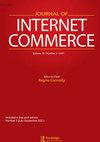A Dual Process Model of the Influence of Recommender Systems on Purchase Intentions in Online Shopping Environments
IF 4.1
Q2 BUSINESS
引用次数: 1
Abstract
Abstract Whereas much research has looked at how recommendation systems influence online purchase intentions, this article illustrates the dual process model by which they occur. Using two studies, we fill the research void in interactive marketing by demonstrating how the dual processes of social proof and risk avoidance mediate the impact of recommendation labels on consumer decision-making contingent upon their level of involvement. Study 1 (n = 73), used a mixed-subjects design with a college student sample to demonstrate that both types of recommendation labels will lead to higher purchase intentions in an online setting. Most importantly, it provides evidence for the main effect of our theoretical model across different product categories. Study 2 (n = 160) provides support for our remaining four hypotheses by demonstrating the underlying process through which recommendation labels have a two-fold effect on purchase intentions. Specifically, the recommendation label increased the risk avoidance effect for high-involvement consumers and enhanced the social proof effect for low-involvement consumers. In both cases, the recommendation labels increased purchase intentions. Implications of our findings for theoretical and practical contributions and future directions are also explored.网络购物环境中推荐系统对购买意愿影响的双过程模型
摘要尽管许多研究都着眼于推荐系统如何影响在线购买意向,但本文阐述了推荐系统发生的双过程模型。通过两项研究,我们通过证明社会证明和风险规避的双重过程如何调节推荐标签对消费者决策的影响,填补了互动营销中的研究空白。研究1(n = 73),使用混合主题设计和大学生样本来证明这两种类型的推荐标签在在线环境中都会导致更高的购买意愿。最重要的是,它为我们的理论模型在不同产品类别中的主要影响提供了证据。研究2(n = 160)通过证明推荐标签对购买意图具有双重影响的基本过程,为我们剩下的四个假设提供了支持。具体而言,推荐标签增加了高参与度消费者的风险规避效果,增强了低参与度消费群体的社会证明效果。在这两种情况下,推荐标签都增加了购买意愿。还探讨了我们的发现对理论和实践贡献的启示以及未来的发展方向。
本文章由计算机程序翻译,如有差异,请以英文原文为准。
求助全文
约1分钟内获得全文
求助全文
来源期刊

Journal of Internet Commerce
BUSINESS-
CiteScore
10.50
自引率
7.00%
发文量
18
期刊介绍:
The business world has undergone many changes because of information technology, and the impact of the Internet may cause one of the biggest yet. While many people use the Internet for educational and entertainment purposes, organizations and companies are looking for ways to tie their internal networks to this global network to conduct electronic commerce. While companies have been conducting business electronically with suppliers and customers for many years, conducting online commerce via the Internet offers even greater opportunities for multinational, national, and even small businesses to cut costs, improve efficiency, and reach a global market.
 求助内容:
求助内容: 应助结果提醒方式:
应助结果提醒方式:


